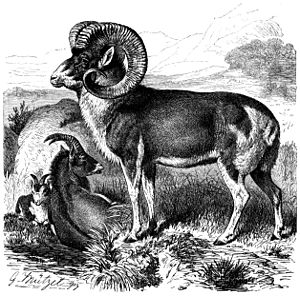Marco Polo sheep facts for kids
Marco Polo sheep (Ovis ammon polii) is a wild sheep, and a subspecies of the Argali.
It takes its name from famed explorer Marco Polo who described the species during his crossing of Pamir (ancient Mount Imeon) in 1271. The Marco Polo sheep is particularly known for its long horns. The longest horn ever found on a sheep was found on a Marco Polo sheep and measured 191 centimeters (75 inches). The sheep is unofficially the National animal of Afghanistan.
Characteristics
The sheep is particularly known for its long, spiraling horns which have been measured having a span up to 140 cm (55 in). They have the longest horns of all sheep, with the longest individual horn ever recorded measuring 1.9 m (6.2 ft) and weighing 60 lb (27 kg). O. a. polii's horns follow a coil pattern, with the tips pointed directly away horizontally from the head; in spite of this, the tips are rarely broken. The horns have long been a popular attraction for trophy hunters. They begin growing 15–20 days after the sheep are born, and their growth in length is most pronounced during the first year. Thickness growth is most noticeable during the first two years.
Ovis ammon sheep are colored a dark brown, with white underparts; the two different sections are separated by a dark band of hair. There is a white patch on the rump as well, which is not so clearly defined on most subspecies except O. a. polii. As winter approaches, the white hair on males grows longer, until it becomes a prominent ruff, although on O. a. polii the ruff stands out less than other subspecies. Females' coats are lighter than the males', and do not have such a drastic seasonal change. The Marco Polo sheep's face is lighter colored than the body.
Most argali have a round tail approximately 6 to 10 centimetres (2.4 to 3.9 in) long, ending in a tuft of hair; O. a. polii's tail is a little bit longer: around 12 to 16 centimetres (4.7 to 6.3 in).
Mature rams on average weigh 126 kg (278 lb). At the withers, rams grow to approximately 113 cm (44 in) in height and ewes to 100 cm (39 in). The sheep rut in December. Gestation lasts about 160 days, with single births being normal and twins uncommon. A captive ewe once gave birth to five lambs at once, then triplets two years later.
Marco Polo sheep have an average life span of 13 years. The horns develop rings each year by which the age of male animals may be determined. Since females do not have horns, it is harder to determine their age.
No data have been compiled showing the susceptibility of the sheep to disease, although tests have been run on similar species of sheep and the data may be similar. Since Marco Polo sheep are reluctant to approach people, it is not likely that they can catch diseases common to domestic flocks, although some domestic sheep are allowed to run wild over the mountains, and it is unknown if they come into contact with Marco Polo sheep. However, the shepherds in the area do not generally have access to veterinary care for their animals, and it is possible that these could transmit diseases to the wild sheep.
Habitat
Most Marco Polo sheep live in the Pamir Mountains region adjacent to the borders of Afghanistan, Pakistan, Kyrgyzstan, Tajikistan and China. Their elevation ranges from 3,700 to 4,800 m (12,100 to 15,700 ft) above sea level. The subspecies lives mainly in the northwestern part of the Hunza district of Pakistan along the Chinese border, inhabiting the Kilik Mintaka border and the northwestern area of Khunjerab National Park. Marco Polo sheep also inhabit the Wakhan Corridor, along the Afghanistan border. They share much of their habitat with animals such as the Siberian ibex. During summer, Marco Polo sheep prefer to be near riparian areas and vegetation, while during winter they prefer to be in gentler and south-facing mountain slopes.
Behavior
Marco Polo sheep are similar in behavior to other members of the genus Ovis. They generally live in small flocks of a few dozen. During the summer, they break into smaller flocks of the same sex. During and after the rut, however, they group together to form larger groups for protection, and to conserve energy.
When the rut begins, rams begin to fight for dominance among their flocks; dominant rams then choose their ewes without competition from the losers. Only mature rams (those over 6 years old) fight for dominance. The young will sometimes threaten older males, but never charge them. The mature rams fight by standing next to each other and spinning around, then one steps back and charges. O. a. polii males have been noted to rise up on their hind legs when they clash with opponents, which is not common in lowland sheep and similar to the fighting habits of goats. The males commonly emit grunts while fighting and often chip their horns or break their noses.
After dominance has been established, the rams begin to select their ewes. Although Marco Polo sheep rams are known to herd females, during the rut males pair off with females to reproduce.
Other pages
Images for kids
See also
 In Spanish: Carnero de Marco Polo para niños
In Spanish: Carnero de Marco Polo para niños




